Was ist Phishing? Arten und Prävention

Phishing ist ein altbewährter Cyber-Sicherheitsangriff, der bis heute die Hauptursache für Datenverstöße weltweit darstellt. Jeder kann Opfer eines Phishing-Angriffs werden, daher ist es wichtig zu wissen, wie man ihn erkennt.
Was ist Phishing?
Die Phishing-Definition beschreibt diese Art von Aktivität als betrügerische Nutzung von elektronischen Kommunikationsdiensten, um Online-Benutzer zu täuschen. Phishing-E-Mails werden mit einem bösen Zweck erstellt - den Benutzer zu täuschen und an sensible und wertvolle Informationen wie Kreditkartendaten, Sozialversicherungsnummer, Passwörter und andere private Details zu gelangen. Phishing-Betrügereien sind bei Hackern sehr beliebt, da sie nicht viel Aufwand und Ressourcen erfordern und eine große Anzahl von Online-Benutzern ansprechen können.
Obwohl sich dieses betrügerische Verhalten bedrohlich anhört, sind nicht alle Phishing-Betrügereien gleich. Die meisten Phishing-E-Mails sind auf den ersten Blick relativ leicht zu erkennen, auch wenn Sie kein Cybersecurity-Experte sind. Sie sind normalerweise schlecht geschrieben, mit schlechter Grammatik, oft drängen sie Sie dazu, schnell zu handeln oder bieten Ihnen ein zu gutes Angebot an, um wahr zu sein. Es gibt jedoch auch organisierte Gruppen von Cyberkriminellen, die sehr effektive Phishing-E-Mail-Hooks verwenden, die hohe Klickraten generieren. In jedem Fall ist es wichtig, so viel wie möglich über dieses Thema zu wissen. Deshalb werden wir in diesem Beitrag die häufigsten Arten von Phishing-Angriffen sowie die besten Maßnahmen zur Phishing-E-Mail-Prävention besprechen.
Arten von Phishing-Angriffen
Während Sicherheitsexperten weiterhin Online-Benutzer darüber aufklären, wie sie die häufigsten Phishing-Versuche verhindern können, tauchen immer wieder neue Phishing-Betrügereien auf. In diesem Sinne ist es wichtig, sich einiger der verbreitetsten Arten von Phishing-Angriffen bewusst zu sein, die derzeit im Internet zirkulieren.

Spear Phishing-Angriffe
Spear Phishing ist ein elektronischer Kommunikationsbetrug oder eine E-Mail, die auf eine bestimmte Person oder Organisation abzielt. Es ist hauptsächlich als Letzteres bekannt und wird hauptsächlich verwendet, um wertvolle Daten vom Gerät des Benutzers zu stehlen oder das Gerät mit Malware zu infizieren. Die Arbeitsweise dieser Art von Betrug ist recht einfach. Der Hacker sendet eine E-Mail an das Ziel und gibt sich als vertrauenswürdige Quelle aus. Der ahnungslose Benutzer öffnet dann die mit einer bösartigen Verknüpfung infizierte E-Mail, die ihn zu einer gefälschten Website führt, die mit Malware gefüllt ist.
Spear Phishing ist eine der häufigsten Phishing-Taktiken unter Hackern. Einer der größten und bekanntesten Spear Phishing-Angriffe war auf Epsilon zurück im Jahr 2011. Das Unternehmen war zu dieser Zeit einer der größten E-Mail-Dienstleister, der durch den Spear-Phishing-Vorfall wertvolle Informationen von über 50 Top-Unternehmen, die den Dienst nutzten, preisgab.
Whaling-Angriffe
Whaling-Angriffe, auch bekannt als CEO-Betrug, sind Phishing-Angriffe, die explizit auf Führungskräfte und leitende Geschäftspartner innerhalb einer Organisation abzielen. Das Hauptziel von Whaling-Angriffen ist es, große Geldbeträge zu stehlen oder sensible Führungsinformationen zu erhalten, um betrügerische Finanztransaktionen zu autorisieren. Auch wenn Sie denken könnten, dass diese Art von Phishing-E-Mails nicht effektiv sind, da sie sich an hochgebildete und erfahrene Personen richten, sind sie überraschend effizient. Natürlich erfordern Whaling-Angriffe wesentlich mehr Forschung und sind raffinierter als die oben genannten Arten, aber sie gehören auch zu den finanziell lukrativsten Arten von Betrug, auf die Hacker setzen.
Stimmen- und SMS-Phishing
Obwohl Phishing-E-Mail-Angriffe bei Weitem die beliebtesten Methoden sind, die Betrüger gerne verwenden, können Phishing-Betrügereien auch über das Telefon durchgeführt werden. Durch Voice Phishing oder Vishing kann der Angreifer ein VoIP (Voice over Internet Protocol) einrichten und vertraute Personen nachahmen, um wertvolle private oder finanzielle Informationen zu erhalten. Eine weitere telefonorientierte Art von Phishing-Betrug ist SMS-Phishing, auch bekannt als Smishing. Wie jede andere Form von Phishing, stellen Betrüger in SMS-Phishing bekannte Entitäten nach und versuchen, den Benutzer dazu zu bringen, persönliche Informationen preiszugeben.
Pharming
Auf diese Weise wird der Benutzer dazu verleitet, seine Anmeldedaten auf der gefälschten Website statt auf der echten einzugeben. Diese Technik ist nicht so verbreitet wie die anderen, wird aber am häufigsten von Angreifern verwendet, die die Kontrolle über die Systeme mehrerer Benutzer haben und über echte und vertrauenswürdige Konten ein Kontrollsystem nutzen können.
Wie man Phishing-Angriffe verhindert
Diese Art von bösartiger Aktivität wird durch sorgfältige Planung und Ausnutzen unterschiedlicher Cybersicherheitslücken durchgeführt. Um jedoch Phishing-Versuche zu verhindern, benötigen Sie eher einen kreativen als einen wissenschaftlichen Ansatz. Es gibt mehrere nützliche Praktiken, die Sie in Ihrem täglichen Leben anwenden können, um Phishing-Angriffe zu verhindern.
Nutzen Sie E-Mail-Filter
E-Mail-Filter sollten als erste Verteidigungslinie dienen. Sie können Filter einstellen, um sich gegen Spam und Phishing-E-Mails zu schützen, indem Sie sie so gestalten, dass sie Nachrichten nach deren Ursprung und Aussehen organisieren. Beachten Sie jedoch, dass Spam-Filter oft auch E-Mails von legitimen Quellen blockieren können, sodass diese Präventionsmethode nicht ganz genau ist.
Öffnen Sie keine verdächtigen E-Mails
Wenn eine Phishing-E-Mail es irgendwie schafft, Ihre Spam-Filter zu umgehen, öffnen Sie sie nicht und klicken Sie nicht auf die in der E-Mail enthaltenen Links. Wie bereits in diesem Beitrag erwähnt, führen diese bösartigen Link-Anhänge Sie oft zu unzuverlässigen Websites, die versuchen werden, Sie dazu zu bringen, persönliche oder finanzielle Informationen preiszugeben oder Ihr Gerät direkt mit Malware zu infizieren.
Achten Sie auf SSL-Zertifikate
Wenn Sie glauben, dass eine E-Mail von einer vertrauenswürdigen Quelle stammt, sich aber nicht ganz sicher sind, ist der beste Weg, dies zu überprüfen, das Überfahren des Link-Anhangs. Sichere Websites verwenden SSL-Verschlüsselung, was bedeutet, dass ihre Adressen mit HTTPS anstelle von HTTP beginnen. In den letzten Jahren hat Google viel Arbeit investiert, um HTTP-Websites, die Informationen sammeln, als unsicher zu kennzeichnen, im Rahmen ihres Plans, das Internet zu einem sichereren Ort für Online-Benutzer zu machen.
Verwalten Sie Ihre Browsereinstellungen
Während wir diese Liste der besten Präventionsmaßnahmen gegen Phishing-Angriffe durchgehen, wird diese Methode oft übersehen, trotz all ihrer potenziellen Vorteile. Unabhängig davon, welchen Browser Sie bevorzugen, können Sie die Browsereinstellungen anpassen, um das Öffnen von bösartigen Link-Anhängen zu verhindern. Die meisten Browser führen eine regelmäßig aktualisierte Liste verdächtiger Websites, um sie zu blockieren, wenn Sie unwissentlich darauf zugreifen.
Integrieren Sie die Zwei-Faktor-Authentifizierung
Mit der zunehmenden Anzahl von Datenverstößen, Phishing-Betrügereien und anderen Sicherheitsbedrohungen wird die Zwei-Faktor-Authentifizierung schnell zu einem Standardverfahren unter Datenschutz-bewussten Online-Benutzern. Durch die Verwendung von 2FA-Schutz fügen Sie eine sichere Ebene hinzu, die dazu dient, all Ihre sensiblen Informationen besser zu schützen, insbesondere wenn Sie ein Unternehmen sind, das potenziell das Ziel eines Whaling-Angriffs sein könnte.
Verwenden Sie Hideez Key
Last but not least, erwägen Sie, Ihre Informationen mit Hideez Key zu sichern. Es ist der zuverlässigste und narrensicherste Weg, sich vor einem Phishing-Angriff zu schützen. Hideez Key überprüft die Glaubwürdigkeit der Website oder App, die Sie öffnen, und gibt Ihre Anmelde- und Passwortinformationen nicht preis, es sei denn, die Ressource ist sicher. Fortgeschrittene Benutzer können auch von anderen Hideez Key-Funktionen profitieren, wie z. B. der OTP-Generierung und MFA. Hideez bietet die Keys sowohl für Einzelpersonen als auch für Unternehmen an.
Oleg Naumenko ist CEO und Gründer von Hideez. Er ist spezialisiert auf passwortlose Authentifizierung, FIDO2-Schlüssel und Zugriffsverwaltungslösungen. Dank seiner umfassenden Erfahrung im Bereich Informationssicherheit unterstützt Oleg Unternehmen bei der Umstellung auf eine passwortlose, Phishing-resistente Mitarbeiterauthentifizierung.



